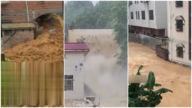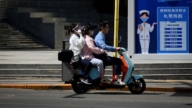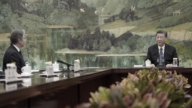【新唐人2014年09月03日訊】中國東北和中原地區多個省份正飽受旱災之苦。河南省將近2個月沒有有效降雨,遭遇了63年以來最嚴重的乾旱。當局已經禁止農民用水澆地,農民連吃水也很困難。然而,這場天災的背後是不是也隱藏著人為的原因呢?民眾懷疑,大旱和「南水北調」工程相關。專業人士指出,「南水北調」違背自然規律,其災害將超過三峽工程。
大陸媒體報導,河南省從今年入夏以來,降水量比往年同期減少60%,是1951年以來,歷史同期最低值。平頂山市的主要水源地,白龜山水庫水位,目前比死水位的97.50米還低。
河南柘城縣雙廟村李女士:「這整個一夏天都沒下來雨。莊稼都旱。就是不讓澆地了,那如果再用井裡水澆地,那保不住連水都吃不到。」
旱情已經對當地農業造成嚴重影響。
李女士:「基本上大部分地方都絕收。有個別能繳上來,還有一點。但是有一點,收不到多少。要是如果說能有四分收成,能收到四分,就是最好的地方」
而水源豐富的湖北省,大部分地區今年主汛期的降雨也減少了20%以上。 111座小型水庫和5萬多口塘堰出現乾涸﹔600多座水庫低於死水位﹔漢江下游河段出現水位下降。丹江口水庫在8月19號8點的水位只有142.77米,遠遠低於「南水北調」規劃的蓄水位170米。
對於這一重大災情,當局解釋說,乾旱是各種氣候原因所致,並且聲稱,即使普遍認為,目前的降水趨勢是「南旱北澇」,也還是要「南水北調」補缺,尤其是嚴重缺水的北京。
但乾旱地區的村民有不同的懷疑。
李女士:「都是這樣認為,是『南水北調』。往年都沒有這幾年這麼旱。」
村民們討論認為,「南水北調」工程把漢江、長江和黃河的水引來引去,三峽還用水庫截流,造成自然流淌的河流方向改變。水循環不暢,地下水資源流失也很嚴重。不僅給周邊的地質和水資源環境帶來嚴重影響,同時還造成水、雲、雨的自然循環系統失衡,從而導致大旱。
旅居德國的水資源專家王維洛,曾多次發表文章說,江澤民以「給2008年北京奧運供水」為名, 2001年匆忙批准上馬「南水北調」工程。每年要把10億立方米的水引入北京,引水渠道要橫穿中原700多條自然河流。工程完全打破了這些河流的自然規律,存在嚴重的工程隱患,甚至比三峽更大,威脅的面積更廣。
北京電力工程師田先生:「從原理上就有問題,因為它並不是說,南邊高,北邊低,自然的流過來的。它要人為的增加很多過程,本身就破壞了自然的規律。我覺的這個可能比三峽還要糟糕。」
「南水北調」工程近期不斷有問題被媒體報導出來。中線工程7月3日首次試水時,媒體爆料說,其取水源頭湖北丹江口水庫的水質含氮量超標,水質污染嚴重。官方也承認水質中氮、磷超標,卻強調長途調運中會自然降解。
7月末,大陸媒體又報導稱,「南水北調」工程蓄水導致漢江水位逐年減少,因水流減弱致河中魚類7月末時還不能產卵,而往年卻早已產卵完畢。位於漢江邊的城市宜城因取不上水,去年以來停水3次,最長時間達48小時。
除了給環境造成迫害,北京電力工程師田先生指出,「南水北調」很可能得不償失。
田先生:「這種非自然過程的話,耗費了很大的能量,而且浪費很多的水份。調十份水的話,最後到北京,可能連兩份也到不了。」
「南水北調」工程有三條調水路線,即東線、中線和西線。其中僅東線和中線的工程造價就達5000億人民幣,比三峽工程大2.5倍。東線是從長江下游抽水,向天津、青島和煙臺方向調水﹔中線是從長江支流漢江的丹江口水庫引水,向北京方向調水﹔西線是從長江上游向黃河引水。東線於2002年12月開工,2013年12月8日通水。中線於2003年12月開工,預計2014年10月通水到北京。西線目前還沒有開工。
採訪/李霞 編輯/周仁 後製/李勇
Henan’s Big Drought. Is This From The South–North
Water Transfer Project?
Several provinces in the Northeast and Central regions of
China are suffering from drought.
For nearly two months Henan Province, without effective
rainfall, suffered the most severe drought in 63 years.
Authorities have banned farmers from watering the land,
farmers have difficulties even with drinking water.
However, are there also human reasons behind natural
disasters?
People suspect the drought and the South–North Water
Transfer Project (SNWTP) are related.
Professionals pointed out, SNWTP is contrary to
the laws of nature;
Damages caused will be more than the Three Gorges Dam.
Mainland media reported that, since this summer, Henan
Province rainfall is 60 percent less than usual over the same
period since 1951, which is the lowest value over the same
period of history.
Pingdingshan City’s main water source, Baiguishan reservoir
water level is even lower than the dead water of 97.5 meters.
Henan Zhecheng County Shuangmiao Village Ms. Li, ”over
the entire summer it did not rain.
The crops are dry. We are not allowed to irrigate the crops.
If I use the well water, I probably cannot even
have drinking water."
Droughts have had a serious impact on local agriculture.
Ms. Li, “most places basically have no harvest. Individual
crops can be harvested a little, but there is not much.
If one place can harvest 40 percent, that’s the best."
Hubei Province is rich in water during the main flood
season this year.
But rainfall in most areas decreased by more than 20 percent.
111 small reservoirs and over 50,000 ponds dried up; over
600 reservoirs are below the dead water level;
Hanjiang River downstream water level dropped.
Danjiangkou reservoir water level is only 142.77 meters
on August 19.
This is far below the SNWTP planned water
level of 170 meters.
For this major disaster, the authorities explained that the
drought is caused by a variety of climatic reasons.
They claimed that, even if the current trend of precipitation
is “north flood south dry", it is still to “transfer water from
south to north" to fill the gap of an especially severe water
shortage in Beijing.
But the villagers in drought regions have different thoughts.
Ms. Li, " we all think it is due to the SNWTP. In previous years,
it was not as dry as in these years."
Villagers discussed and believe that, SNWTP leads the Han
River, the Yangtze River and the Yellow River water back
and forth; the Three Gorges Reservoir also caused natural
flowing rivers to change direction.
Poor circulation, and loss of groundwater resources are
also very serious.
It has a massive impact not only to the surrounding
geological environment, but also caused imbalances
to the water, clouds, rain, and natural circulation system
leading to a severe drought.
Living in Germany, water resources expert Wang Weiluo,
has published many articles about Jiang Zemin who to
“supply water to the 2008 Beijing Olympics", hastily
approved and launched the SNWTP in 2001.
It introduced one billion cubic meters of water annually to
Beijing, with diversion channels crossing more than 700
natural rivers in Central China. The project completely
broke the law of nature of these rivers;
There is a serious engineering problem, even bigger than
the Three Gorges, and the threat is to a wider area.
Beijing electrical engineer Mr. Tian, “in principle there is a
problem, because it is not that the south is high, the north is
low, and it naturally flows across. It is to artificially add a
number of processes, which undermines the law of nature.
I think this may be even worse than the Three Gorges Dam."
Problems have been reported recently about SNWTP
by the media.
When the Diversion project tested the water on July 3 for
the first time, the media exposed that the water source
from Danjiangkou Reservoir exceeded the nitrogen content,
and was seriously polluted.
The official also acknowledged that water quality for
nitrogen and phosphorus exceeded the standards.
However he stressed that it would naturally degrade
through long-distance transportation.
In late July, the mainland media also reported that SNWTP
led to a decrease in the Han River water level,.
Due to the reduced water flow the fish were unable to
spawn by end of July, while in previous years they had
finished spawning.
Yicheng city located by the Han River was without water
three times since last year, the longest time was 48 hours.
In addition to the environmental damages, Beijing electrical
engineer Mr. Tian pointed out that the drain from SNWTP is
likely to outweigh the benefits.
Mr. Tian, “this unnatural process takes a lot of energy and
wastes a lot of water.
Introduce ten percent water, and finally arriving in Beijing,
maybe even not two percent will get there."
SNWTP has three water diversion routes, namely the east,
middle and west line.
Of which the middle and east lines cost amounted to 500
billion yuan, 2.5 times larger than the Three Gorges Project.
The East line is pumped from the Yangtze River to Tianjin,
Qingdao and Yantai direction.
The Midline is from Danjiangkou Reservoir as a division of
Yangtze tributary the Han River, in Beijing’s direction;
The West line is from the upper Yangtze River to the Yellow
River water diversion.
The East line started in December 2002, until December 8,
2013 the water went through.
The Midline started in December 2003, is expected to have
water through in October 2014.
The West Line has not been started yet.
Interview/LiXia Edit/ZhouRen Post-Production/LiYong





























